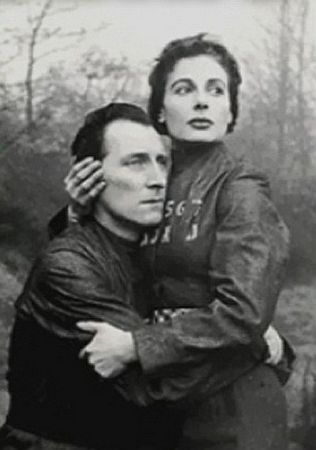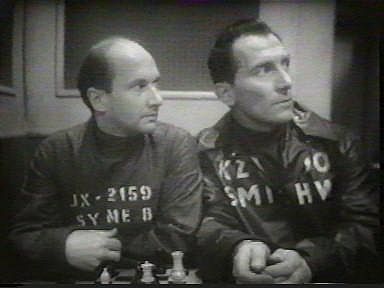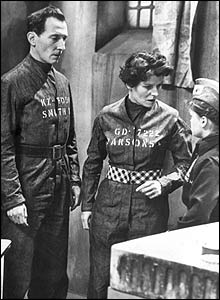Nineteen Eighty-Four in 1954: The BBC TV adaptation
Dir: Rudolph Cartier
Star: Peter Cushing, Yvonne Mitchell, André Morell, Donald Pleasence.
It’s hard to appreciate the impact the BBC adaptation of George Orwell’s Nineteen Eighty-Four had on the country at the time. The first of the two broadcasts, in December 1954, triggered an enormous furor, with motions proposed in Parliament criticizing “the tendency, evident in recent British Broadcasting Corporation television programmes, notably on Sunday evenings, to pander to sexual and sadistic tastes.” When the performance was repeated the following week, needless to say, it got the biggest television audience in the country since the Coronation of Queen Elizabeth II. [Some things don’t change!]
That was not a repeat of the original screening, as both broadcasts were largely performed live, with some filmed inserts to allow for scenery, costume, etc. changes. Fortunately, the second showing was recorded; this being the days before video-tape (which would become available a couple of years late), the process basically involved filming a TV monitor, and the resulting picture quality leaves more than a little to be desired, especially when you start watching it. However, the brain adapts, and the grainy, ghostly quality of the images eventually ceases to matter.
It’s important to put the broadcast into the context of the time, in a post-war Great Britain, where rationing, such as of meat, had still been in place up until as little as six months previously. The Cold War was entering perhaps its chilliest phrase, following the death of Stalin in 1953, with the Korean War also fresh in everyone’s mind. Indeed, even the book itself was freshly-published rather than a cobwebby cornerstone of Eng. Lit. courses everywhere, having come out only five years previously.
What we have here, is a pretty straightforward retelling of the novel, with Winston Smith (Cushing) revolting against the authoritarian world of the Inner Party and its leader – who may or may not exist – Big Brother. He falls for another rebel, Julia (Mitchell) and seeks to join the underground resistance, of which Inner Party member O’Brien (Morell) is a member. Except (and I trust this hardly counts as a spoiler), O’Brien is no such thing, and Smith ends up arrested and undergoing tortures both mental and physical, culminating in his experience in Room 101, all with the aim of getting him to love Big Brother as he should.
The adaptation was written by Nigel Kneale, one of the most-renowned British genre scriptwriters of all time – in his field, easily as important as Dennis Potter, with his work including the Quatermass serials (as well as Quatermass and the Pit) and The Stone Tape. The film also lucks into a main star and a supporting actor who were little known at the time, but would go on to become horror icons of the highest order, in Cushing and Pleasence. The former is sublime, and his Smith is definitive in a way of which John Hurt could only dream, and goes alongside Cushing’s portrayals of Van Helsing, Baron Frankenstein and, arguably, Sherlock Holmes. Pleasence is his usual solid self as Syme, promoter of Newspeak, who is eventually “disappeared,” like one of the words he is striving to erase.
The supporting cast is not much less familiar. Morell gives a brilliant performance as O’Brien, delivering the film’s signature line with the perfect mix of deadpan menace and absolute certainty: “If you want a picture of the future, imagine a boot stamping on a human face— forever.” He and Cushing would team up, in a more friendly way, in Hammer’s Hound of the Baskervilles, where Morell played Dr. Watson to Cushing’s Holmes. Also present are Wilford Brambell, who’d go on to renown as Steptoe, and antique shop owner Mr. Charrington is Leonard Sachs, who compered variety show The Good Old Days for thirty years.
A couple of things stand out about how this was made. The budget was reportedly just £3,249 – even allowing for inflation, it works out to less than £70,000 in today’s money. It’s an astonishingly low sum, especially considering things like the live orchestra which played the music during the performances. The special effects, depicting the bombarded city of London, though sparse, are certainly effective. Again, you have to bear in mind, this was shown barely a decade after Hitler’s V-2’s were falling on the nation’s capital. Depicting the resulting rubble would have had much the same emotional resonance for the audience here, as the Twin Towers falling does for today’s viewer.
The adaptation being performed live is also remarkable – something that was common at the time, but hardly ever happens for dramas nowadays – a 1958 Armchair Theatre performance, during which one of the actors died, didn’t help [One of the survivors said of that incident, “We could see him coming up towards us, but we saw him fall. We had no idea what had happened, but he certainly wasn’t coming our way. The actors started making up lines, ‘I’m sure if so-and-so were here he would say’…”] In the case of Nineteen Eight-Four, 22 sets were used and it’s almost impeccable. You can see what appears to be the shadow of a boom-mike early on, otherwise it seems near-perfect, and it’s hard to tell this isn’t a multiple-take production.
The black-and-white cinematography, though not a stylistic choice at the time, captures the grim, depressing reality of a hardcore totalitarian regime beautifully – the eighties version was originally intended to be shot in b/w too. As a necessary contrast to the soulless society depicted here, the performances, particularly Cushing and Mitchell, imbue things with humanity, and provide a tinge of hope, even as things go downhill for Smith, with relentless grimness – the moment where Smith sees his reflection in a mirror is not one easily forgotten. It’s a combination, when added to the mix of past and future, that makes it easy to tell why its reputation persists.
And it does: in 2000, it was ranked #73 in the BFI’s list of the greatest British TV shows of all time. It was the earliest program honoured, and put Nineteen Eighty-Four between Walking With Dinosaurs and The Fall and Rise of Reginald Perrin. The film has only been shown three times on television since the original broadcast, most recently as part of the celebrations for Orwell’s centenary. However, the fifty-year copyright term on the show expired at the end of 2004, allowing it to enter the public domain, so it’s now available on Youtube. I’d certainly recommend checking it out.


